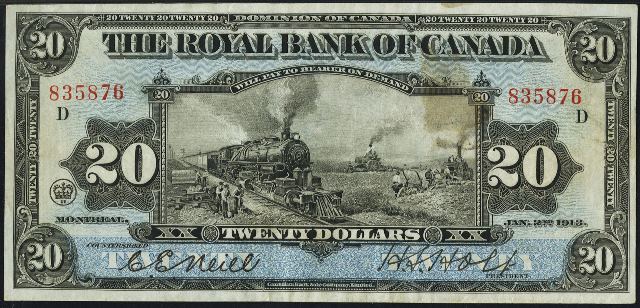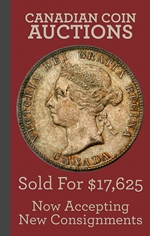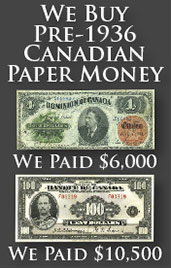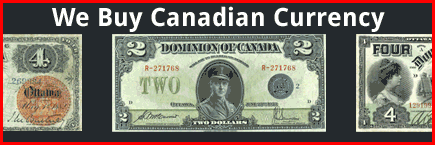We Buy All Canadian Currency
Printed Before 1936
We Also Accept Consignments for Manifest Currency Auctions
Email Us: Manning@CanadaCurrency.com or Call or Text: 864-430-4020
Thank you! -Manning Garrett
Value of Old Banknotes from The Royal Bank of Canada in Montreal
Old Money from The Royal Bank of Canada in Montreal
As most of us are probably aware, The Royal Bank of Canada is still operating throughout the world today. The bank originally opened in 1864 in Halifax, Nova Scotia as The Merchants Bank. In 1901, in an attempt to become more worldly, the bank changed its name to The Royal Bank of Canada and it moved to Montreal. The Royal Bank of Canada printed currency from 1901 until 1943. Some notes are only worth a few dollars over the face value. Others can be worth thousands of dollars. Our guide below has more information. Please contact us if you would like a free appraisal or would like an offer on your bank note.
1901 $5 Bills:
Five dollar bills are the lowest denominated bank note issued by The Royal Bank of Canada in 1901. As you might expect, this is the most “common” denomination for that year; but it is still difficult to locate. We know that 333,000 of these bank note sheets were printed. That leaves room for survivors, but not a tremendous amount.
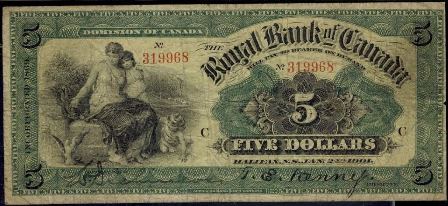
1901 $10 Bills:
All 1901 bank notes issued by The Royal Bank of Canada in Montreal were printed by The American Bank Co. Ottawa. They printed 130,000 of these ten dollar bills in sheets of four. Each bill on the sheet had the same serial number – that is 520,000 total notes. That might seem like a lot, but not many have survived.
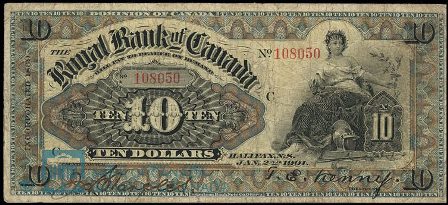
1901 $20 Bills:
All bank notes from 1901 have an engraved date of Jan. 2nd 1901. These were issued in January right when the bank changed names. Each denomination from 1901 comes in two varieties. The signature of T.E. Kenny can be typed or engraved. Twenty dollar bills are actually quite rare, especially with the engraved signature. Only 29,000 sheets of these were printed (for both varieties combined).
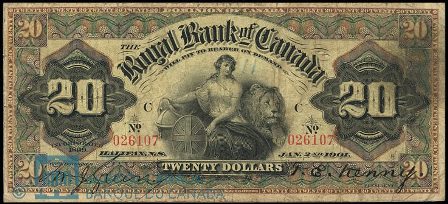
1901 $50 Bills:
Records show that only 16,000 Jan 2nd 1901 $50 bills were issued by The Royal Bank of Canada in Montreal for use throughout Canada. These have a beautiful vignette of a ship. Don’t expect to come across these very often.
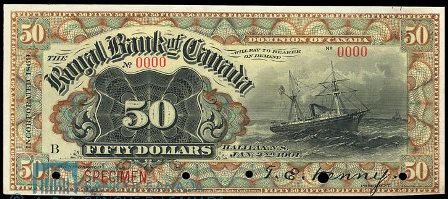
1909 $5 Bills:
Approximately 500,000 sheets of Jan. 2nd 1909 five dollar bank notes were issued by The Royal Bank of Canada in Montreal. There are two varieties for this issue. The 5s in the four corners on the front of the note can have a black or a green background. We have a green note shown below. Black notes are worth about twice as much.
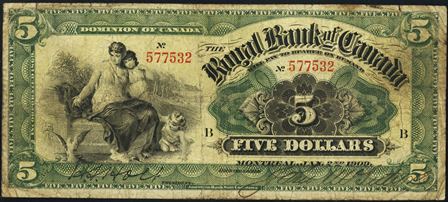
1909 $10 Bills:
There are two varieties for the Jan. 2nd 1909 ten dollar bill issued by The Royal Bank of Canada. The more common variety (shown below) has a black frame. The rare ones have a multicolored frame. Both types are relatively rare though. Prices start at about $500 and go up sharply from there based on condition. Records show that approximately 250,000 sheets of both varieties (combined) were issued.
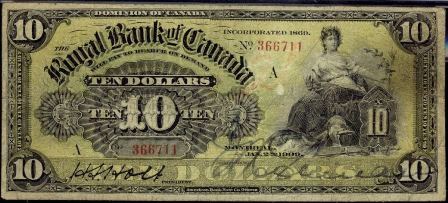
1909 $20 Bills:
January 2nd 1909 twenty dollar bills can have a lovely blue frame as seen below. Or they can have the much rarer multicolored frame. Multicolored notes are very rare; blue frame notes are worth at least $1,000, and usually a lot more based on their actual grade. Only 55,000 total sheets of 1909 $20 bills were issued by The Royal Bank of Canada in Montreal.
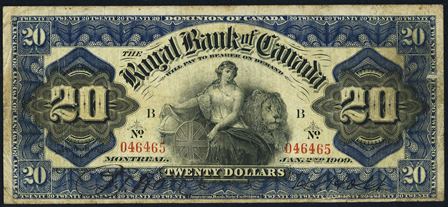
1909 $50 Bills:
We are showing the rare multicolored frame below. The American Bank Note Co. Ottawa printed all 1909 bank notes for The Royal Bank of Canada. Each note should be signed by H.S. Holt and another person. All Jan 2nd 1909 $50 bills are extremely rare. Only 22,000 of them were printed and released for circulation.
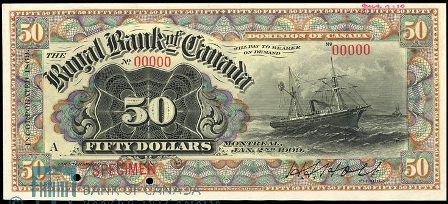
1913 $5 Bills:
Nearly 4.5 million sheets of Jan 2nd 1913 five dollar bank notes were issued by The Royal Bank of Canada. So these definitely aren’t rare, but high grade examples still sell for good money. There are two varieties for all 1909 notes. Any note that has a typed signature of C.E. Neill will be worth a little bit less money than the same note without a Neill signature. All of these five dollar bills have a portrait of Edson L. Pease and Herbert S. Holt.
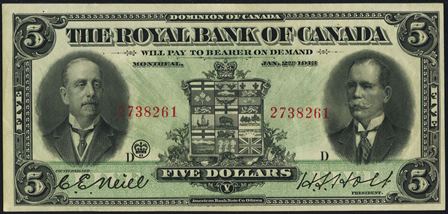
1913 $10 Bills:
Some of these 1913 ten dollar bank notes were printed by The American Bank Note Co. Ottawa; others were printed by The Canadian Bank Note Company, Limited. More than 3.2 million sheets of these were issued. Uncirculated examples are very difficult to find. Lower grade notes are readily available for reasonable prices.
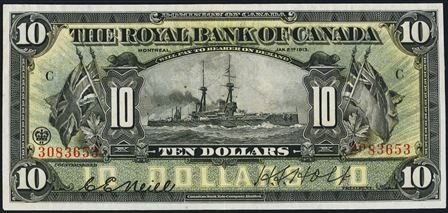
1913 $20 Bills:
A little more than 900,000 sheets of 1913 $20 bills were issued by The Royal Bank of Canada in Montreal. That makes these fairly scarce. Low grade example can be bought for around $750. Nice looking lightly circulated notes sell for more money.
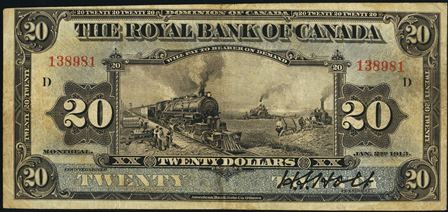
1913 $50 Bills:
If you have a Jan 2nd 1913 $50 bill then you definitely want to check out the signature. Notes without a typed Neill signature sell for about twice what the standard Neill notes bring. Edson L. Pease is shown on the front of each $50 bank note. There were 214,000 of these printed.
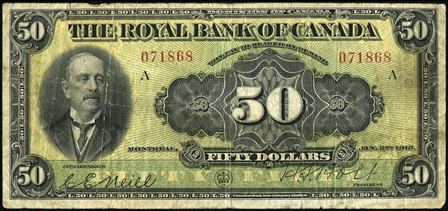
1913 $100 Bills:
The first one hundred dollar bank notes were issued by The Royal Bank of Canada in 1913. Only 100,000 were printed. Despite that tiny output, these actually aren’t classic rarities. Close to twenty are known to exist. That is still a small number in the scheme of things, but that is a lot for a high denomination printed in the early 20th century.
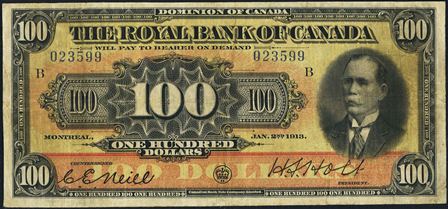
1927 $5 Bills:
Serial numbering started over in 1927. So we know that exactly 2,969,500 sheets of these bank notes were issued by The Royal Bank of Canada in Montreal. There are two varieties for each denomination. Some are signed by Neill and others are signed by Wilson. All notes are signed by Holt. Neill notes are worth about 15% more for this denomination.
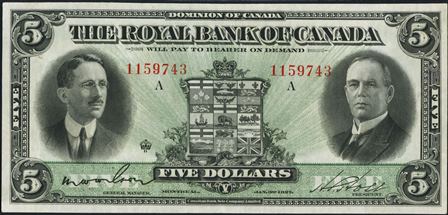
1927 $10 Bills:
C.E. Neill and Herbert S. Holt are pictured on the front of both $5 and $10 bills from 1927. If you have a ten dollar bill then be sure to check for a Neill signature. Neill notes are worth about 25% more than Wilson notes. Records show that a total of 2,309,000 sheets of Jan 3rd 1927 ten dollar notes were issued by The Royal Bank of Canada.
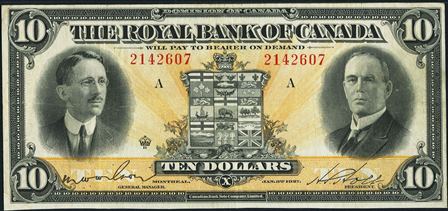
1927 $20 Bills:
We know that 576,500 sheets of $20 bills were issued by The Royal Bank of Canada. These were printed by The Canadian Bank Note Company, Limited. Your standard 1927 $20 bill is probably worth $200. However, if it is signed by Neill, then you can multiply that figure by about three. Neill signatures are very rare for this denomination.
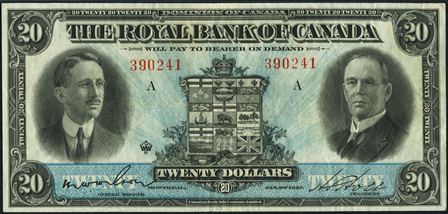
1927 $50 Bills:
Mr. Edson L. Pease is the only person featured on the front of January 3rd 1927 $50 bills. The Royal Bank of Canada in Montreal issued 1,200,000 1927 $50 bills. Notes with a Neill signature are very rare. Wilson signature notes sell for about $500 in poor condition. Prices can go up quickly from there based on condition.
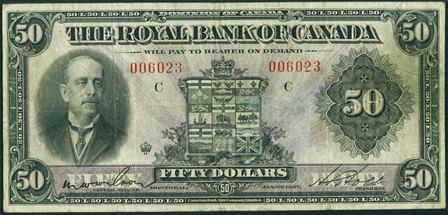
1927 $100 Bills:
Herbert S Holt is pictured on and signed each 1927 $100 bill issued by The Royal Bank of Canada. A total of 82,000 of these were issued. That is a very small number, but the survival rate is surprisingly high. Contact us if you need exact value information.
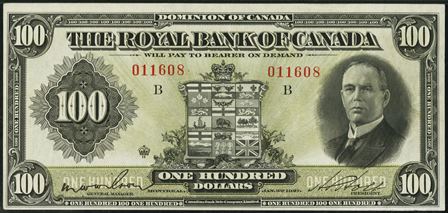
1933 $5 Bills:
The Royal Bank of Canada issued 1.2 million July 3rd 1933 five dollar bills. Each note is signed by and has a portrait of Morris W. Wilson and Sir Herbert Holt. There are no varieties to this issue. Values are based purely on condition.
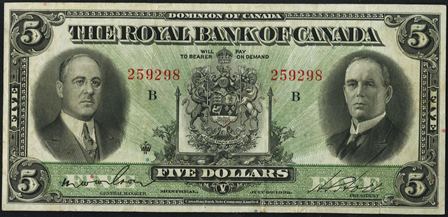
1933 $10 Bills:
The Canadian Bank Note Company, Limited printed 800,000 July 3rd 1933 $10 bills for The Royal Bank of Canada in Montreal. Low grade notes sell for around $150. High grade notes are of course worth much more.
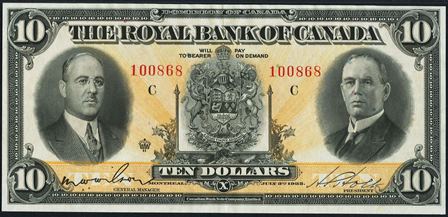
1933 $20 Bills:
Records show that 100,000 1933 twenty dollar bills were printed. However, there is no evidence that they were released for circulation. Today only specimens exist.
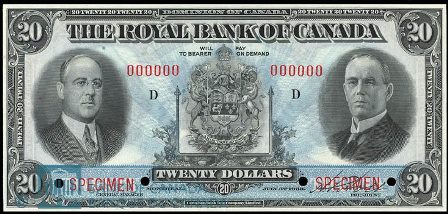
1935 $5 Bills:
All denominations from 1935 come in two varieties based on the size of their signatures. All the bank notes we have shown have the more common “large” signatures. These have the standard Jan. 2nd engraved date. The year has been updated to 1935.
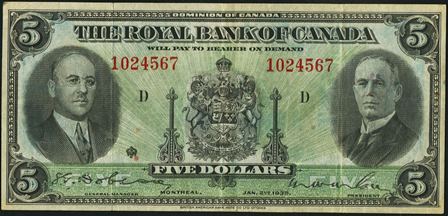
1935 $10 Bills:
All bank notes from January 2nd 1935 have portraits of Morris Wilson and Sir Herbert Holt. We have a large signature note shown below. You can spot large signatures because Dobson’s signature touches Montreal. A small signature would be obviously smaller. Please contact us if you aren’t sure which type you have.
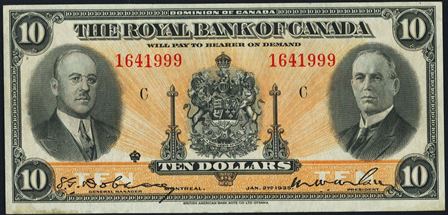
1935 $20 Bills:
All of these 1935 bank notes from The Royal Bank of Canada in Montreal were printed by The British American Bank Note Co. Ltd Ottawa. These have smaller dimensions than previous paper money from this institution. Please contact us if you need help valuing your Jan. 2nd 1935 twenty dollar bank note. We happily provide offers and free appraisals.
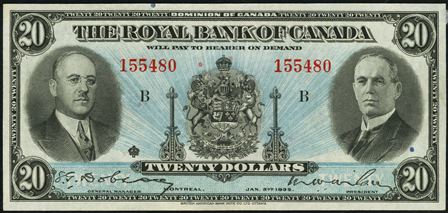
1943 $5 Bills:
Five dollar bills were the last bank notes issued by The Royal Bank of Canada. Sadly, that doesn’t really make them special. Hundreds of these exist, but they are still needed for year sets. This is also the only chance to get a note with the signature and portrait of S.G. Dobson. Morris W. Wilson is also pictured on and signed Jan. 2nd 1943 five dollar bills.
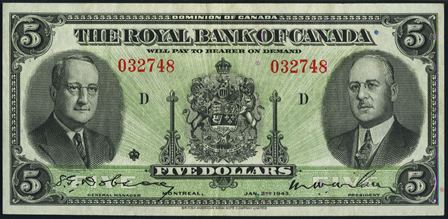
Overprinted St. John’s Antigua 1913 $5 Bills:
These are very rare bank notes. We have a specimen shown below. An issued bank note would have a serial number. These were printed by The American Bank Note Co. Ottawa for The Royal Bank of Canada. Jan. 2nd 1913 notes like this have a blue overprint that reads as “Antigua” and “Payable At St. John’s Antigua”. We would love the chance to purchase one of these five dollar bills.
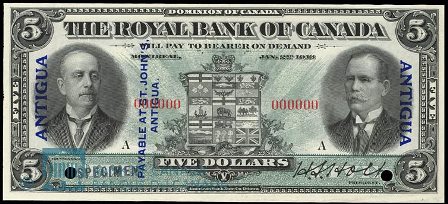
St. John’s Antigua 1920 $5 Bills:
This is the first year that bank notes were specifically engraved and issued for use in St. John’s, Antigua. It is thought that 60,000 of these were printed. As you might expect, these are quite rare today. Like many other notes, these are also denominated in pounds. These have text that reads “The Royal Bank of Canada, Will Pay To The Bearer On Demand, At St. John’s Antigua, The Sum Of Five Dollars, In Antigua Currency Being The Equivalent Of One Pound And Ten Pence, Redeemable Only In Antigua.” The actual bank note shows a steamship. The engraved date on these $5 bills is January 2nd 1920.
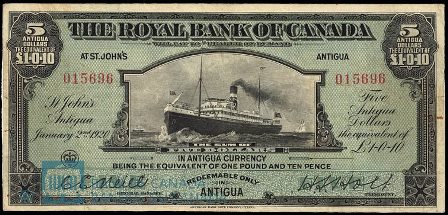
St. John’s Antigua 1938 $5 Bills:
We don’t know exactly how many of these January 3rd 1938 $5 bills were printed. However, we do know that as of this writing, at least a dozen are held by collectors.
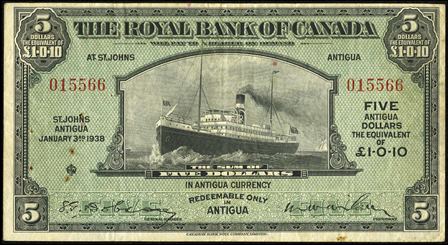
Overprinted Bridgetown Barbados 1909 Bank Notes:
These are very rare and desirable bank notes. The overprint should be in dark blue ink. It reads as “Barbados” and “Payable At Bridgetown, Barbados.” All notes are dated as Jan. 2nd 1909. We know that 60,000 $5 bills, 12,000 $20 bills, and 1,500 $100 bills were issued. Those are tiny quantities. Survivors are few and far between.
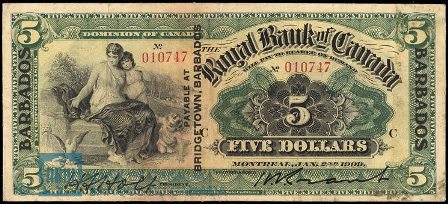
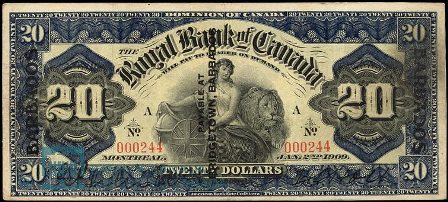
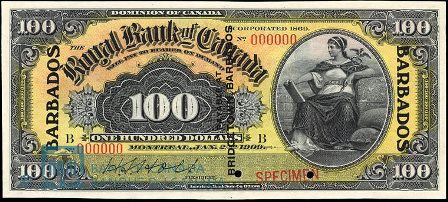
Bridgetown Barbados 1920 Bank Notes:
These are more modern than the earlier 1909 Bridgetown, Barbados notes, but notes from 1920 are equally rare. 60,000, 8,000, and 2,000 five, twenty, and one hundred dollar bills were issued by The Royal Bank of Canada for use in Barbados. Each note is dated as January 2nd 1900.
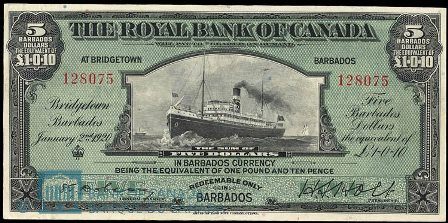
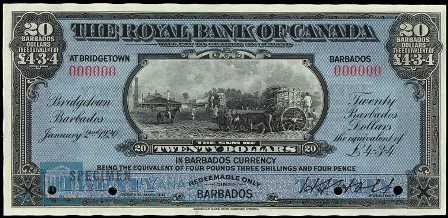
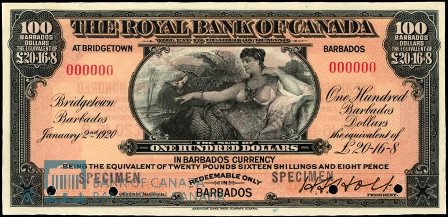
Bridgetown Barbados 1938 Bank Notes:
The Royal Bank of Canada issued five and twenty dollar bank notes for use in Bridgetown, Barbados. These are also denominated as one pound ten pence and four pounds three shillings and four pence. Five dollar bills are occasionally available. twenty dollars bills are very rare though. Each note is dated as January 3rd 1938 and there is specific text that states that the money is redeemable only in Barbados.
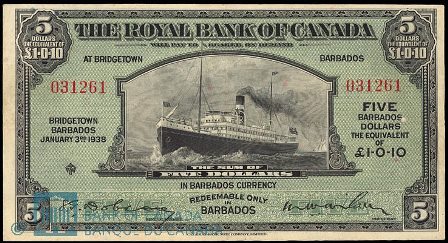
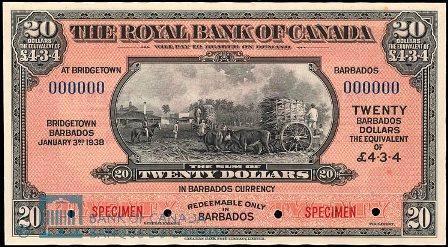
Overprinted Georgetown British Guiana 1909 & 1913 Bank Notes:
The Royal Bank of Canada ordered some five, twenty, and one hundred dollar bills to be overprinted as “British Guiana” and “Payable At Georgetown, British Guiana”. The two lower denominations were dated as Jan. 2nd 1913 and $100 bills can have the 1913 or Jan. 2 1909 date. Five dollar bills are occasionally available. All other years are extremely scarce.
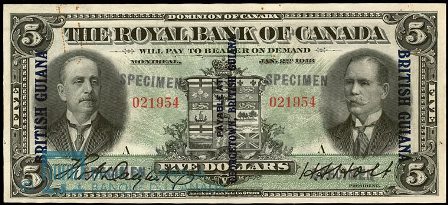
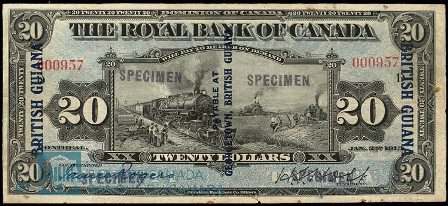
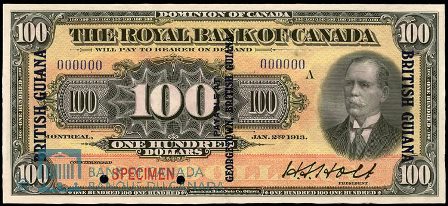
Georgetown British Guiana 1920 Bank Notes:
These are the same designs we have seen all other 1920 West Indies notes issued by The Royal Bank of Canada. We have a $5, $20, and $100 bill shown below. The five dollar bill is an issued bank note. The others are specimen notes. Specimens are always less valuable than issued bank notes. Issued notes have serial numbers and two signatures. 1920 five dollar Georgetown, British Guiana notes are occasionally available; more than a dozen are known exist. That makes them the most plentiful note for Georgetown. The $20 and $100 bills issued in 1920 are much rarer.
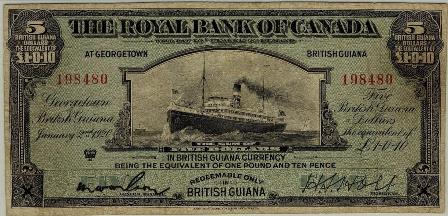
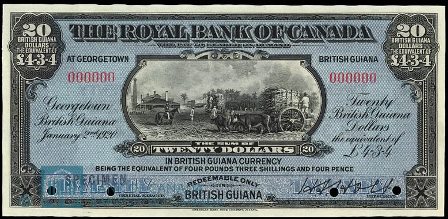
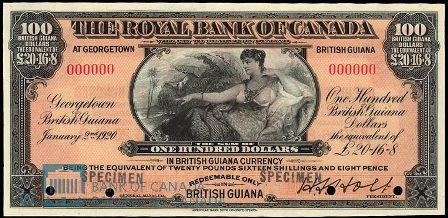
Georgetown British Guiana 1938 Bank Notes:
The Canadian Bank Note Company, Limited printed five and twenty dollar bills for The Royal Bank of Canada in 1938. The money seen below was only for use in Georgetown, British Guiana. It is interesting to note that the $20 bills are actually more common than the $5 bills. Normally high denominations are scarcer, but that is not the case here.
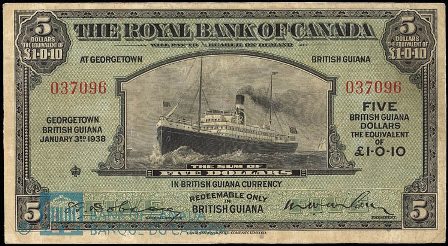
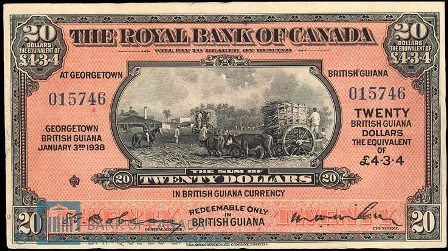
Overprinted Roseau Dominica 1913 Bank Notes:
The Royal Bank of Canada only issued five dollar bank notes for use in Roseau, Dominica. Examples from 1913 are by far the rarest for this location. Each note should have a blue overprint that reads “Dominica” and “Payable At Roseau Dominica.” Please let us know if you have one of these available for sale.
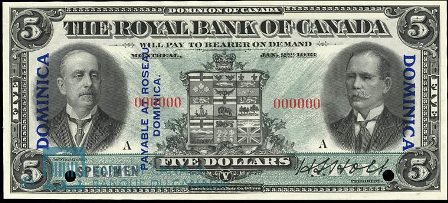
Roseau Dominica 1920 Bank Notes:
It is currently thought that a half dozen January 2nd 1900 $5 bills from Roseau, Dominica are known to exist. That may seem like a small number, but that actually makes it one of the more available Royal Bank of Canada Caribbean notes. These almost always sell for $2,000 or more. Contact us for exact pricing.
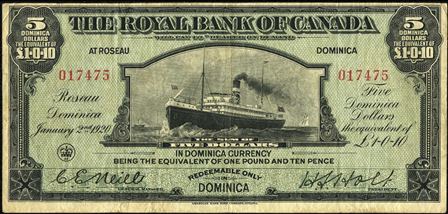
Roseau Dominica 1938 Bank Notes:
All Royal Bank of Canada Caribbean notes are also denominated in pounds, shillings, and pence. So the five dollar bill seen below equals one pound and ten pence. These were printed by The Canadian Bank Note Company Limited and dated as January 3rd 1938.
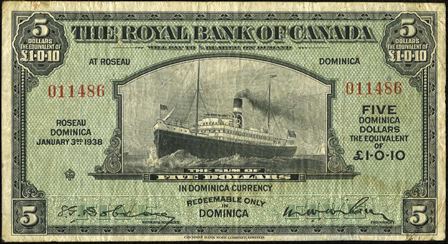
Overprinted St. George’s Grenada 1909 Bank Notes:
All paper money issued by The Royal Bank of Canada for use in St. George’s, Grenada is very rare. Even specimens (unissued bank notes as seen below) are worth good money. Records indicate that 20,000 Jan 2nd. 1909 St George’s notes were issued. These should certainly exist in higher quantities than they do.
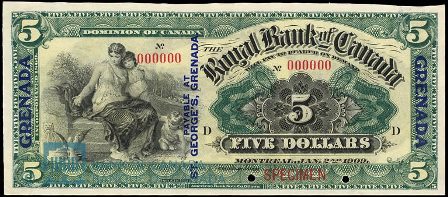
St. George’s Grenada 1920 Bank Notes:
The Royal Bank of Canada issued 60,000 1920 $5 bills for use in St. George’s Grenada. Most currency from 1920 is relatively available. However, these bank notes happen to be very rare. Contact us for details.
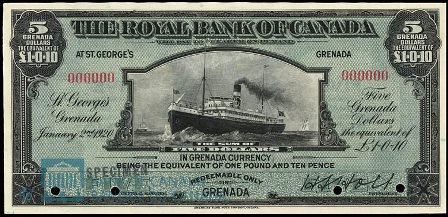
St. George’s Grenada 1938 Bank Notes:
We don’t know exactly how many January 3rd 1938 five dollar bills The Royal Bank of Canada issued for use in Grenada. We do know that these are rare bank notes in general, but they are the most common for the location. Prices start at a $2,000, but they can be worth considerably more based on their actual grade.
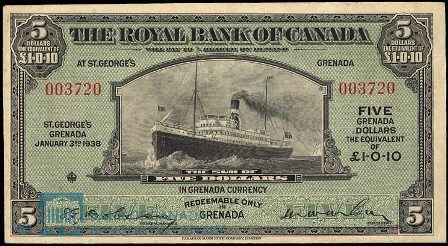
Kingston Jamaica 1911 Bank Notes:
These are interesting bank notes. Not only are they the lowest denomination issued by The Royal Bank of Canada for use in the Caribbean, they are also denominated in pounds. Thanks to their slightly lower value, these have survived in higher numbers. They can still be very expensive though. Five pound notes have a numismatic value that is about twice as high as one pound notes. Each denomination is dated as Jan. 2nd 1911.
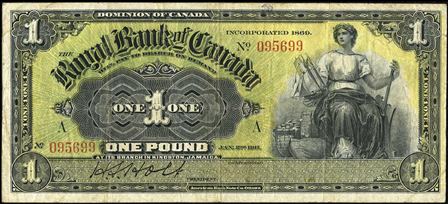
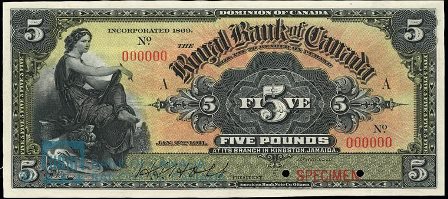
Kingston Jamaica 1938 Bank Notes:
Official printing records show that The Royal Bank of Canada issued 108,000 one pound notes and 8,000 five pound notes dated as January 3rd 1938. Close to twenty one pound notes exist. Only a handful of five pound notes are available to collectors. So needless to say, the higher denomination certainly sells for a premium.
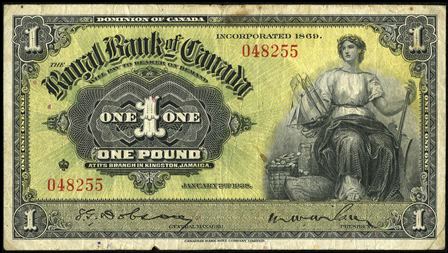
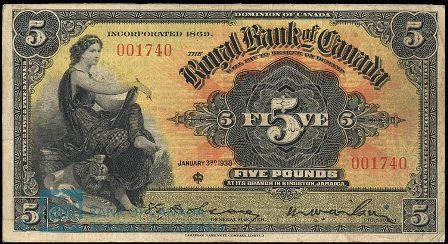
Overprinted Basseterre St. Kitts 1913 Bank Notes:
Basseterre is the capital of St. Kitts. The Royal Bank of Canada had a branch bank there as early as 1913. They issued five dollar bills only. We know that 40,000 were printed. The design is the same as all 1913 $5 bills, but these have a blue overprint that says “St. Kitts” and “Payable At Basseterre St. Kitts.” These are very rare bank notes. We would welcome the chance to purchase one.
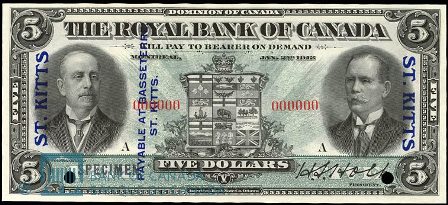
Basseterre St. Kitts 1920 Bank Notes:
January 2nd 1920 $5 bank notes from St. Kitts are very rare. Only 60,000 were issued by The Royal Bank of Canada. The exact number of survivors can never be said for certain because new discoveries are made all the time. Needless to say though, odds are that 99.99% of that original 60,000 have been destroyed forever.
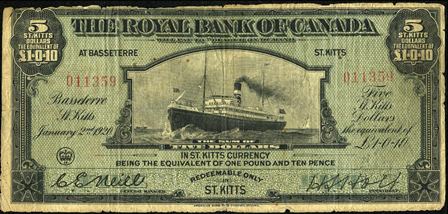
Basseterre St. Kitts 1938 Bank Notes:
Basseterre notes from January 3rd 1938 are the most common notes for the island city. A low grade example should cost around $2,000. A note in VF condition or better should be worth at least two or three times more than that though. Please contact us for exact pricing.
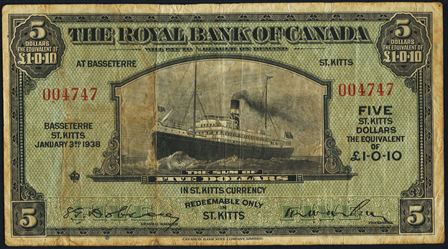
Castries St. Lucia 1920 Bank Notes:
Bank notes from Castries St. Lucia are very unique. First of all, only 20,000 were printed. Unlike all other Caribbean locations in which The Royal Bank of Canada had branches, currency was only issued in Castries for one year. Each five dollar bill is dated as January 2nd 1920. It has the same design and standard language found on all other Caribbean currency. As you might expect, these are very rare. We would pay $10,000 for an example even in poor condition. High grade notes would be worth more money. Please contact us for details.
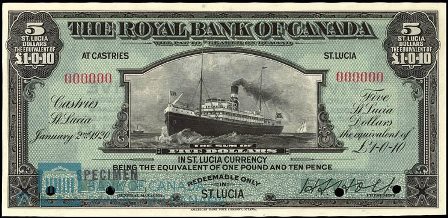
Overprinted Port of Spain Trinidad 1909 Bank Notes:
Paper money issued by The Royal Bank of Canada for use in Port of Spain, Trinidad is the most common of the bank’s Caribbean issues. Of course that doesn’t mean that all of these notes are cheap, they are just the most available. Bank notes from 1909 are interesting because they have a red overprint. All other overprinted notes are in black or blue ink. Five dollar bills are occasionally available. Twenty and one hundred dollar bills from 1909 are extremely rare. Here are the printing numbers: $5 Bills – 260,000. $20 Bills – 8,000. $100 Bills – 7,000. That should explain why $20 and $100 bills are scarce.
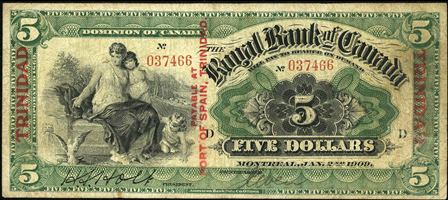
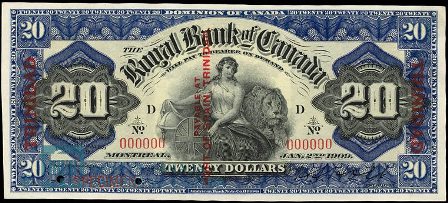
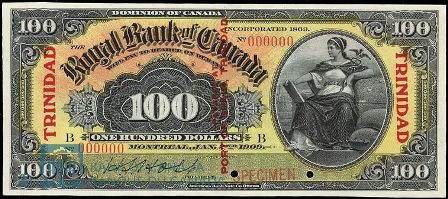
Port of Spain Trinidad 1920 Bank Notes:
We do not known how many Port of Spain, Trinidad bank notes were issued in 1920 by The Royal Bank of Canada. All denominations are known to exist. Five dollar bills are by far the most common. Surprisingly though, $100 notes are actually about four times more common than 1920 $20 bills. However, 1920 $100 bills definitely sell for more money. Contact us for pricing details.
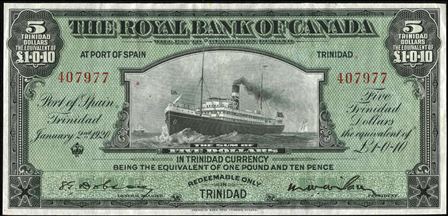
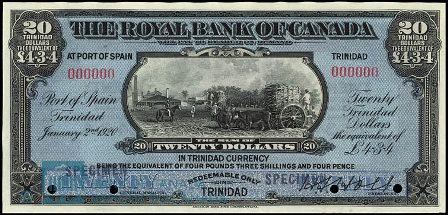
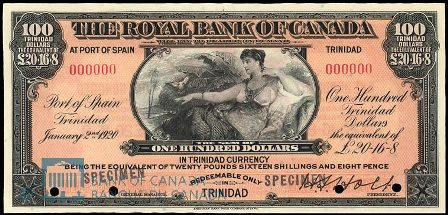
Port of Spain Trinidad 1938 Bank Notes:
Five and twenty dollar bills dated as January 3rd 1938 were issued by The Royal Bank of Canada for use in Port of Spain, Trinidad. More than thirty of the $5 bank notes are known to exist. Only a half dozen $20 bills are thought to currently be held by collectors.
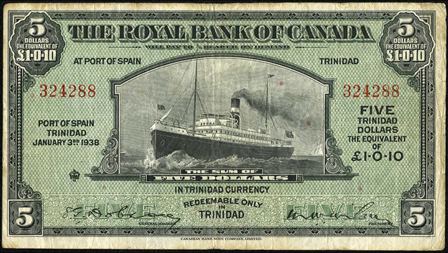
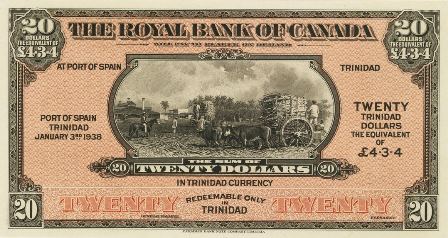
GOT SOMETHING TO SELL?
We buy all types of Canadian currency. We are especially interested in bank notes from The Royal Bank of Canada in Montreal. We frequently pay thousands of dollars for both rare and/or high grade notes. We are also aggressive buyers of their West Indies / Caribbean notes. You never know what you have until you ask. You might be surprised at how much money we can offer for some currency. Send us an email with pictures of the front and back of your bank note and we will respond quickly with our offer.
Manning@CanadaCurrency.com
Sample Bank Note Image:
Your piece of currency from The Royal Bank of Canada could look similar to the one seen below. Our sample note is just one of dozens of denominations and design types. So don’t worry if your bank note is different. Our guide above has lots more information. Contact us for more value information.
